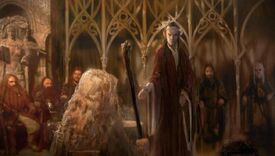- For other uses of The Council of Elrond see also: The Council of Elrond (disambiguation).

The Council of Elrond as seen in Peter Jackson's film The Fellowship of the Ring
The Council of Elrond was a secret council called by Elrond in Rivendell in order to decide what should be done with the One Ring, during the Great Years in the Third Age.
Soon after Frodo had recovered from the stab-wound from the Witch-king at Weathertop, Elrond called this council together to discuss the fate of the One Ring.
The account of the Council dominates Book II, Chapter 2 of the first volume, The Fellowship of the Ring, which is named after it.
What was discussed
During the Council, the full story of the Ring was told by Bilbo and Gandalf. Elrond and the others agreed that this was indeed the One Ring, based on evidence provided by Gandalf.
Gandalf related his meeting with Saruman and subsequent imprisonment by that traitorous wizard in Orthanc.
Boromir described the dream he and his brother Faramir had experienced, and which led him to come to Rivendell. He pleaded that the Ring should be used to aid Gondor in her struggle against Mordor, but was told that it would inevitably corrupt anyone who used it. Only a mighty person could hope to wield the Ring against Sauron, and they would in time become a new Dark Lord whether they wished it or not. Boromir reluctantly accepted this conclusion.
Glóin spoke of evil messengers who had come to the Lonely Mountain promising the return of one or more of the Seven rings if they would reveal the location of Bilbo Baggins. The possibility of war with Sauron's allies in the region was troubling, but Gandalf was relieved that at least Smaug the dragon was no longer around for the Dark Lord to use. They had also came seeking news of what happened to Balin, who went to Moria in 2989 with Ori and Óin .

The Council in session
Legolas conveyed the bad news that Gollum had escaped captivity and disappeared. Aragorn had gone to great lengths to capture the debased creature, who had possessed the Ring for centuries under the Misty Mountains. After his capture, Aragorn and Gandalf had interrogated the miserable Gollum, and found to their dismay that he had been to Mordor. Apparently, while under torment there, Gollum had confessed both that he had held the One Ring and that Bilbo had taken it to the Shire.
After much debate about the fate of the Ring, it was decided that the only way to be free of Sauron's evil was to cast the Ring into the Crack of Doom in Mount Doom (in Mordor), where it would be unmade. This might well undo the power of the three Elf-rings, but would certainly render Sauron impotent and free Middle-Earth from his menace forever.
Tom Bombadil was also mentioned as a possible ring bearer since the ring took no effect on him, but Gandalf stated that Tom would most likely lose it as Tom seemed to be very nonchalant about the War of the Ring.
It then became necessary to decide who should take responsibility for such a perilous undertaking. Bilbo offered to finish the job he had started, but Gandalf told him he could not take back the Ring. Frodo surprised everyone (including himself) by announcing that he would take the Ring, and after some thought Elrond agreed. At this point Sam emerged from hiding and demanded to accompany Frodo, and since it was hardly possible to separate them Elrond agreed.
The matter of who else should accompany Frodo (later to be known as the Fellowship of the Ring, hence the title of the book and subsequent movie) was decided later, although the movie version of The Fellowship of the Ring depicts the choosing of the Fellowship as taking place at the end of the Council, and has Merry and Pippin also eavesdropping on the proceedings and demanding to accompany Frodo.[1]
Those present at the Council had arrived at Rivendell by different paths and on separate errands, yet they were all ultimately concerned with the Ring and its effect upon the people of Middle-earth. Important participants at the Council were:
- Elrond - a Half-elven conveyor, member of White Council and lord of Rivendell.
- Erestor - an Elf-lord, advisor, and the chief of the House of Elrond.
- Gandalf the Grey - a Wizard, one of the Istari, and member of both the White Council and The Fellowship.
- Aragorn - a Ranger, heir of Isildur, member of The Fellowship, and Chieftain of the Dúnedain in the North.
- Frodo Baggins - a Hobbit of the Shire, member of The Fellowship, and Ring-bearer.
- Bilbo Baggins - a Hobbit of the Shire, former Ring-bearer, uncle of Frodo and long resident in Rivendell.
- Boromir of Gondor - son of Denethor II Ruling Steward of Minas Tirith, and member of The Fellowship.
- Glóin of the Lonely Mountain - representative of the King under the Mountain, Dain Ironfoot of the Dwarves.
- Gimli - son of Gloin, member of The Fellowship, and dwarf of the Lonely Mountain.
- Legolas - a Sindar Elf of the Woodland Realm (Mirkwood), son of Thranduil the Elvenking, and member of The Fellowship.
- Glorfindel - an Elf-lord of Rivendell, rescuer of Frodo and his company from the Nine.
- Galdor of the Havens - messenger from Círdan of the Grey Havens.[1]
References
- ↑ 1.0 1.1 The Lord of the Rings, The Fellowship of the Ring, Book Two, Chapter II: "The Council of Elrond"
